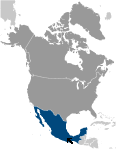World Atlas: Mexico. On this page you can see the map, country flag and many detailed information about the people, history and economy of Mexico.

Here you can find online selected information about the geography, inhabitants, government, economy and history of Mexico. Included are selected statistics, an overview map and the detailed map of Mexico. But let's start with the flag of Mexico here:
Mexico - Overview:
What you should know about Mexico? Let's start with this: The site of several advanced Amerindian civilizations - including the Olmec, Toltec, Teotihuacan, Zapotec, Maya, and Aztec - Mexico was conquered and colonized by Spain in the early 16th century. Administered as the Viceroyalty of New Spain for three centuries, it achieved independence early in the 19th century. Elections held in 2000 marked the first time since the 1910 Mexican Revolution that an opposition candidate - Vicente FOX of the National Action Party (PAN) - defeated the party in government, the Institutional Revolutionary Party (PRI). He was succeeded in 2006 by another PAN candidate Felipe Calderon, but Enrique PENA Nieto regained the presidency for the PRI in 2012. The global financial crisis in late 2008 caused a massive economic downturn in Mexico the following year, although growth returned quickly in 2010. Ongoing economic and social concerns include low real wages, high underemployment, inequitable income distribution, and few advancement opportunities for the largely indigenous population in the impoverished southern states. Since 2007, Mexico's powerful drug-trafficking organizations have engaged in bloody feuding, resulting in tens of thousands of drug-related homicides.
Geography of Mexico
 Where on the globe is Mexico? The location of this country is North America, bordering the Caribbean Sea and the Gulf of Mexico, between Belize and the United States and bordering the North Pacific Ocean, between Guatemala and the United States. Total area of Mexico is 1,964,375 sq km, of which 1,943,945 sq km is land. So this is very large country. How could we describe the terrain of the country? This way: high, rugged mountains; low coastal plains; high plateaus; desert. The lowest point of Mexico is Laguna Salada -10 m, the highest point Volcan Pico de Orizaba 5,636 m. And the climate is varies from tropical to desert.
Where on the globe is Mexico? The location of this country is North America, bordering the Caribbean Sea and the Gulf of Mexico, between Belize and the United States and bordering the North Pacific Ocean, between Guatemala and the United States. Total area of Mexico is 1,964,375 sq km, of which 1,943,945 sq km is land. So this is very large country. How could we describe the terrain of the country? This way: high, rugged mountains; low coastal plains; high plateaus; desert. The lowest point of Mexico is Laguna Salada -10 m, the highest point Volcan Pico de Orizaba 5,636 m. And the climate is varies from tropical to desert.
Inhabitants of Mexico
Let's take a look how many people live in Mexico. The number is: 124,574,795 (July 2017 est.). So this country is among the most populous in the World. Who lives here? mestizo (Amerindian-Spanish) 62%, predominantly Amerindian 21%, Amerindian 7%, other 10% (mostly European). What are the languages in Mexico? Spanish only 92.7%, Spanish and indigenous languages 5.7%, indigenous only 0.8%, unspecified 0.8%. And the religions: Roman Catholic 82.7%, Pentecostal 1.6%, Jehovah's Witness 1.4%, other Evangelical Churches 5%, other 1.9%, none 4.7%, unspecified 2.7% (2010 est.). How old are the people in average? 28.3 years. We have to add that this number is the median - so one half of the people is older than this, one half is younger. And what is their life expectancy (at birth)? This: 76.1 years. Where the people live in Mexico? Here: most of the population is found in the middle of the country between the states of Jalisco and Veracruz; approximately a quarter of the population lives in and around Mexico City. The major urban areas of Mexico are: Mexico CITY (capital) 20.999 million; Guadalajara 4.843 million; Monterrey 4.513 million; Puebla 2.984 million; Toluca de Lerdo 2.164 million; Tijuana 1.987 million (2015).
Government and Economy of Mexico
The capital of Mexico is Mexico City (Ciudad de Mexico) and the government type federal presidential republic. Let's take a look at the administrative divisions - 31 states (estados, singular - estado) and 1 city (ciudad); Aguascalientes, Baja California, Baja California Sur, Campeche, Chiapas, Chihuahua, Coahuila, Colima, Cuidad de Mexico, Durango, Guanajuato, Guerrero, Hidalgo, Jalisco, Mexico, Michoacan, Morelos, Nayarit, Nuevo Leon, Oaxaca, Puebla, Queretaro, Quintana Roo, San Luis Potosi, Sinaloa, Sonora, Tabasco, Tamaulipas, Tlaxcala, Veracruz, Yucatan, Zacatecas. Regarding the economy of Mexico, important industrial products are food and beverages, tobacco, chemicals, iron and steel, petroleum, mining, textiles, clothing, motor vehicles, consumer durables, tourism. Important agricultural products are corn, wheat, soybeans, rice, beans, cotton, coffee, fruit, tomatoes; beef, poultry, dairy products; wood products. The most important export commodities are manufactured goods, oil and oil products, silver, fruits, vegetables, coffee, cotton and the most important export partners are US 81% (2016). The most important import commodities are metalworking machines, steel mill products, agricultural machinery, electrical equipment, automobile parts for assembly and repair, aircraft, aircraft parts and the most important import partners are US 46.6%, China 18%, Japan 4.6% (2016). How rich is Mexico and how rich are people in this country? The most important number here is GDP per capita (PPP): $19,500 (2017 est.). This is quite good. Let's add that this means Gross Domestic Product per person, which is recalculated with respect to the relative cost of local goods and services. And one more important number - population below poverty line: 46.2%.